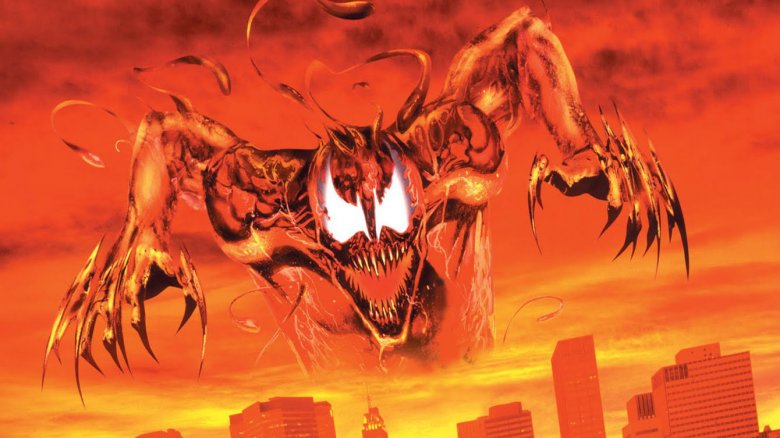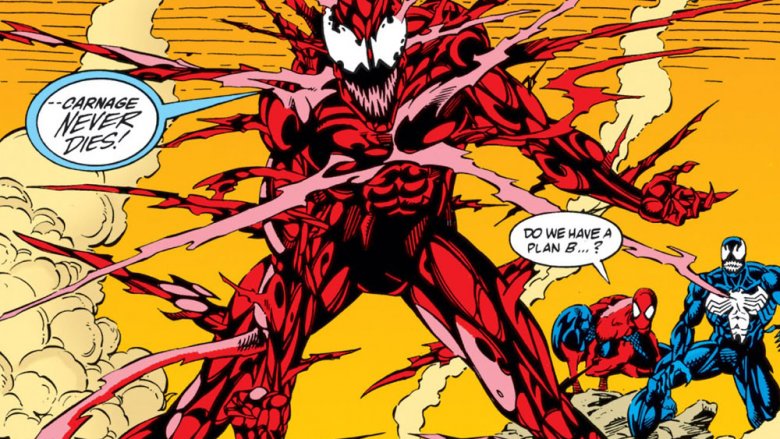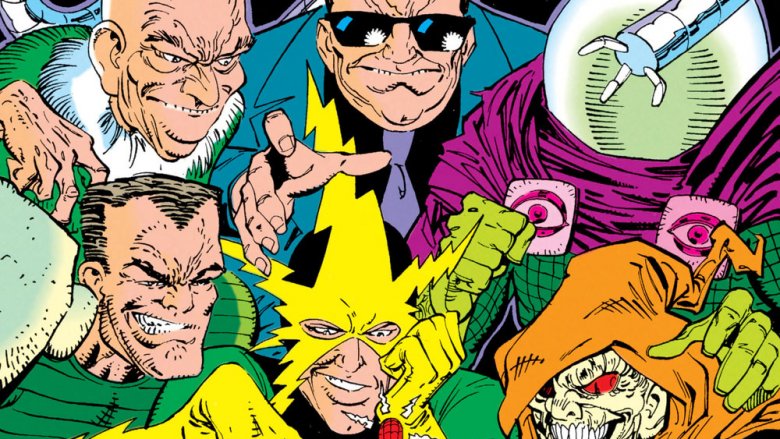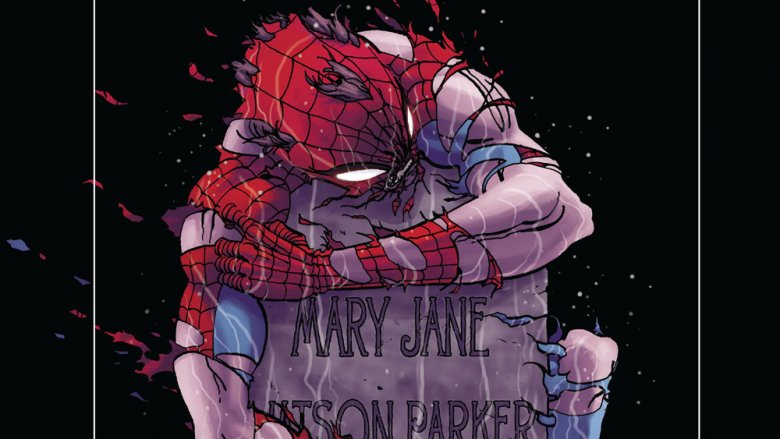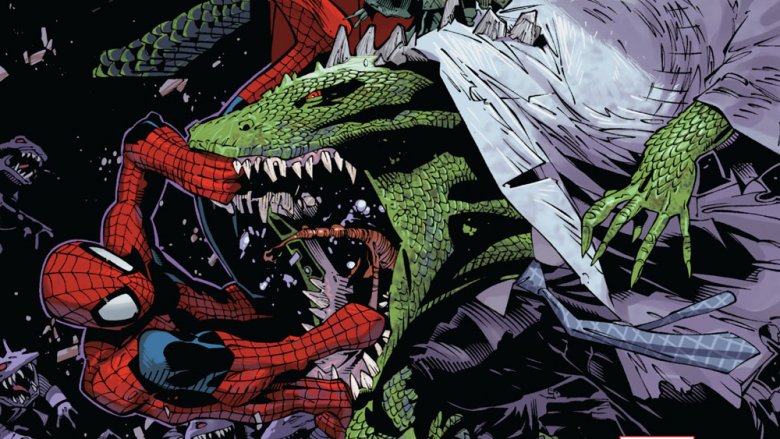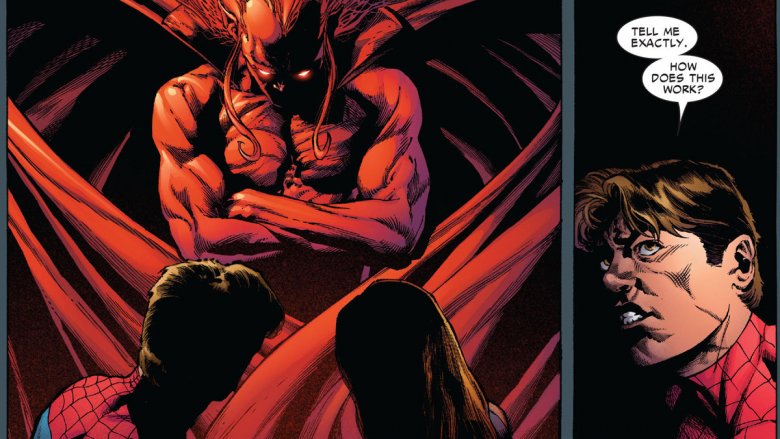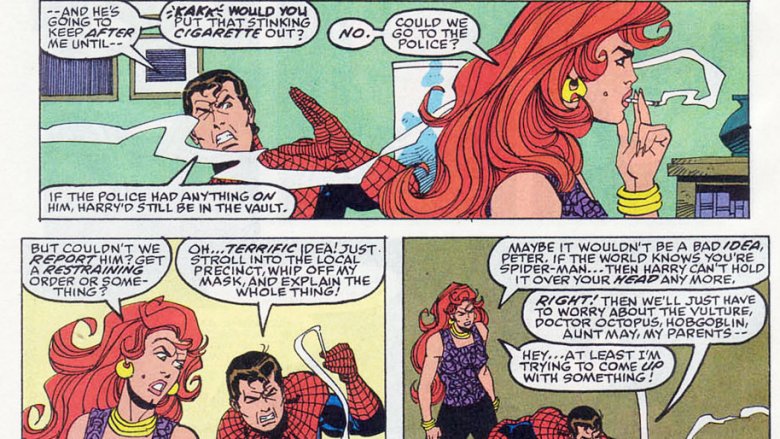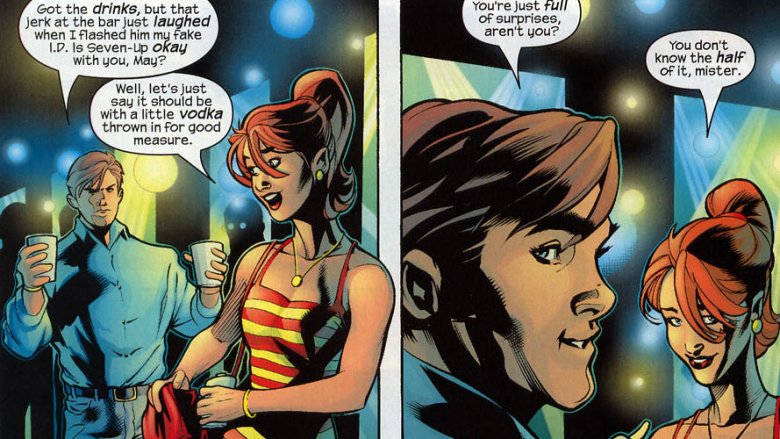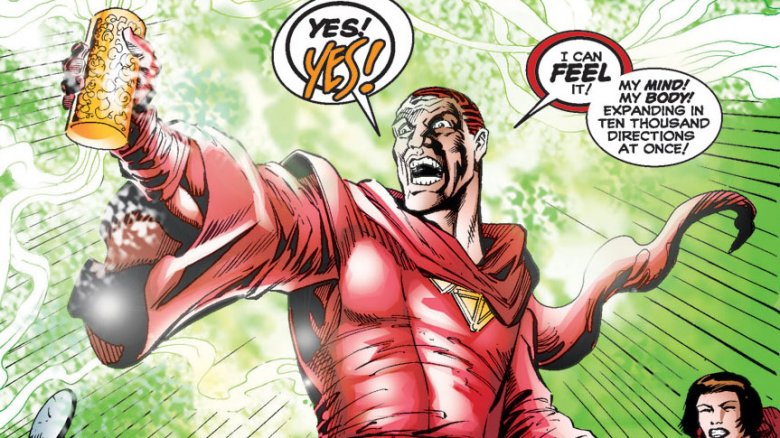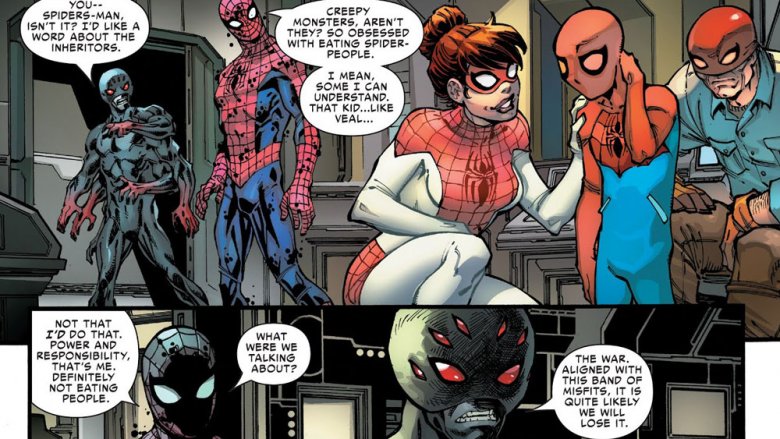Spider-Man Stories They'll Never Make A Movie About
The Marvel Cinematic Universe has a long and proud history of directly adapting comic book stories for the big screen. Iron Man 3, for instance, was heavily based on the "Extremis" story arc in the Iron Man comics. Captain America: The Winter Soldier lifted its plot from the comic of the same name. And of course, there's a whole lot of the original Infinity Gauntlet saga in the last two Avengers films, right down to Thanos using the Infinity Stones to turn someone into a stack of cubes.
The Spider-Man films, however, are a little different. While they've definitely recreated key scenes like Spidey struggling out from under the rubble in Spider-Man: Homecoming, the major plot points in those movies are mostly original to the big screen. Mysterio never hoodwinked Spider-Man into fighting Elementals in Europe, for example, and while Peter Parker certainly had a rough time in high school, he never went out with the Vulture's daughter. Of course, that means if Marvel Studios did want to adapt a Spider-Man comic, there's plenty to choose from ... and plenty more that they probably wouldn't touch with a ten-foot pole. Here are the Spider-Man stories they'll never make a movie about.
Maximum Carnage is way too weird for a Spider-Man movie
At first glance, 1993's Maximum Carnage seems like a slam dunk for a big-screen adaptation. It was one of the decade's hottest and most memorable stories, and it was adapted into a 16-bit video game that plenty of moviegoers have fond memories of. It's got a villain who's basically just the Joker with Spider-Man powers, which is an easy sell for the audience. Plus, it's a big, bold, action-packed story.
And it would make for a terrible movie.
Admittedly, the biggest obstacle here has way less to do with the story itself than it does with the complicated world of licensing and film rights. The entire hook of the story is based on Venom and Carnage showing up for a gigantic crossover brawl, and that's not likely to happen anytime soon. Those characters currently exist in an entirely separate cinematic universe. Of course, there's nothing that says Disney and Sony won't exchange a few million dollars to make it happen, but even if you put that aside, there are a whole lot of plot points that make it tough to adapt.
For one thing, it's long. The original comic ran over 14 issues, and it's mostly the same fight scene over and over with slight variations in who's trying to punch Carnage this time. It's great for a video game, but not for a movie. Then there's the massive scale of the story, which features New York City in flames. But what really pulls it out of contention is how full-on bonkers it is. Carnage has a team of sidekicks that includes a floating zombie and a demonic Spider-Man with six arms and segmented eyes. That's not even counting Deathlok, the zombie cyborg from the future who's fighting with the good guys. Yeah, it's a lot, and unless the Marvel movies are willing to get even weirder than they already are, Maximum Carnage is just too much.
Revenge of the Sinister Six is a bit too silly
The original Sinister Six story in Amazing Spider-Man Annual #1 is one of the all-time classics, an epic that puts the web-slinger through a gauntlet of his greatest foes. If you wanted to make a bet on stories that were likely to influence future Spider-films, that would be a good one to put your money on. The story where the bad guys come back, however? That one is a little ... odd.
It seems pretty simple at first. Doctor Octopus gathers the other members of the Sinister Six (with Hobgoblin substituting for Kraven the Hunter, who was temporarily deceased at the time), tempting them into a team-up with a promise of taking over the entire world. Seems like a bit of a big step for a group that had trouble beating up one 16-year-old in a leotard, but hey, the plan is solid. They hijack a space shuttle, load it up with a concentrated poison for which they have the only cure, and then hold the entire planet for ransom until they are made "the masters of the world!"
Then you get to the twist. It turns out that it wasn't actually poison, and Doc Ock's actual plan is, well, here's how he explains it: "That formula will make cocaine addiction a thing of the past! After breathing it, any attempt to use the drug will result in extreme convulsions! And the sole antidote is ... Burundite! Fortunately, you fools stole the world's only Burundite for me! And with so many rich and powerful individuals slaves to cocaine — and willing to do anything to remain that way — I'm certain I can parlay my supply of Burundite into enough influence to, indeed, rule the world — alone!" So yeah. He wants to take over the world with a cocaine rocket. He does not succeed.
The best part? The whole thing ends with Spider-Man just calling Thor and asking him to deal with it. Now that we're thinking about it, that would actually work pretty well in the MCU.
Reign is a little too raunchy for the MCU
The X-Men films have had their ups and downs over the past 20 years, but 2018's Logan was one of the most well-received by critics and fans, with good reason. Hugh Jackman's final outing as an older, beaten-down Wolverine in a future that was somehow even more dystopian than usual featured incredible performances, and was even nominated for an Academy Award for Best Adapted Screenplay. If the execs over at Marvel Studios wanted to recapture that magic for another movie, they might take a look at Spider-Man: Reign. That look would last about 30 seconds, and then they'd start looking elsewhere.
Reign is essentially a cover version of Frank Miller's The Dark Knight Returns, with Spider-Man swapped in for Batman. It's the future, everything sucks, everyone's old and sad, and almost the entire cast is dead by the end of it. None of that is the problem, though — you could describe Logan the same way — and neither is the idea of slapping a bucket full of old-man makeup on Tom Holland. No, the problem here is a plot point that comes up pretty early in the story, explaining why sad, old Peter Parker is a widower. See, Mary Jane Watson died of cancer as a result of "loving" Spider-Man.
She got the cancer from Peter's radioactive, uh, body fluids. Yeah. We've seen a lot of things we never expected to get on the big screen over the past few years — like, we had an actual movie with Spider-Ham in it — but there's got to be be some kind of a limit, and that is definitely past it.
Shed will never get a movie because it's too messed-up
Just because a story wouldn't work on the big screen doesn't make it a bad one. There are plenty of really, really solid Spider-Man tales published over the years that just wouldn't work in film in general, or even the MCU in particular. Shed is absolutely one of those. It's a great comic, but it definitely wouldn't fit.
It's arguably the single best story about Curt Connors (the Lizard), and that seems like an easy sell to audiences. The Lizard is, after all, one of Spider-man's oldest villains, with plenty of pathos and the kind of personal connection to Peter Parker that movies love to explore. He's even relatively familiar to movie audiences from his appearances in both the Sam Raimi Spider-Man trilogy and the The Amazing Spider-Man. A story that really digs into the way that he works and makes him a far more threatening villain would be great for a movie, right? Yeah, until you remember that this is a story about how the Lizard "sheds" the Connors personality and embraces his cold, murderous lizard brain, free of any compassion.
And the way that he finally severs his connection to his humanity? Well, there's no easy way to say this, but Curt Connors, the Lizard, eats a boy ... like, a human boy. Specifically, he eats his own boy, Billy Connors. Seriously, we can't stress this enough — he eats a boy. Villains do villainous things, but just straight-up familial cannibalism probably wouldn't fit in with the relatively lighthearted tone of the MCU Spider-Man movies, which up to this point have been almost completely free of boys being eaten.
The devil's in the details with One More Day
Here's your spoiler warning for Spider-Man: Far From Home, but if you've seen it, you already know that it ends with Peter's secret identity being revealed to the entire world. It might not surprise you to learn that this once happened in the comics, too. But there, Peter chose to unmask thanks to peer pressure from Tony Stark.
With that in mind, you might think that the MCU's version of Spider-Man's outing might resolve itself in the same way that it did in the comics, but that's highly unlikely. For one thing, the MCU seems mostly okay with heroes who don't really have secret identities — Spidey might actually be the only one who does in the entire universe. But it's mainly because the story where Peter's identity is revealed, "One More Day," ends with Spidey and Mary Jane making a deal with the devil to stuff that genie right back in the bottle.
It's definitely possible that this could happen. Even though Mephisto, the particular devil in question, doesn't exist in the MCU yet, Dormammu is there at the end of Doctor Strange with his head on fire and everything, so there's definitely some kind of dark power out there. That said, while we have to imagine that it's slightly more palatable for audiences than, say, eating a boy, it stands to reason that Marvel might not want its flagship hero making any Satanic pacts in what's essentially a movie for children. It's kind of a bad look.
Smoking Mary Jane is a story we'll never see on the screen
This is less of a "story" than a long-running subplot, but considering it lasted for about 25 issues of Amazing Spider-Man (and the other monthly Spider-Man titles that were going on at the same time), it's definitely one of those pieces of Spider-history that could be dug up for a movie. Of course, the operative word there is "could." It would also be accurate to say "won't."
Basically, the saga of Mary Jane Watson as a smoker was exactly what it said on the tin. Stressed out from her husband constantly being in mortal danger from fighting bad guys like Carnage and the Green Goblin, MJ takes up a bad habit and starts smoking cigarettes. This leads to a long series of arguments where Peter delivers wide-eyed, earnest speeches about how smoking is every bit as dangerous as fighting Tombstone, but with the added detriment of making MJ smell terrible. She even almost gets fired from her job on a soap opera when she won't stop smoking on set, because apparently, cigarettes in the Marvel Universe make you incredibly stupid. Eventually, MJ gets yelled at in public by a dude who's allergic to tobacco smoke, which causes her to finally quit.
There are two big problems with this one. First, a few years back, Marvel put a blanket ban on any of their characters smoking at all, including long-time cigar-chompers like Wolverine and Nick Fury, in an effort to set a better example for younger fans. Second, and perhaps more importantly, the current crop of Spider-Man movies are focused on teens, and MJ — with her interest in true crime and irony — seems like a particularly accurate portrayal of today's youth. Teens in 2019 just don't seem all that interested in smoking cigarettes. If MJ suddenly got super into Juul, though, now we're getting somewhere.
Trouble would be a troublesome Spider-Man movie
Even by the standards of superhero comics, Trouble is a weird one, and not just because it's arguably the worst Spider-Man comic ever printed. A truly bizarre experiment put out in 2003, it wasn't even originally billed as a superhero comic (and it featured photo covers of two swimsuit models instead of art). Instead, it was touted as a lighthearted romance romp, a teen comedy about four young people who got a job at a country club and spent one magic summer scheming on how to lose their virginity.
What does any of this have to do with Spider-Man? Well, the four kids in question were named Richard, Ben, Mary, and May. Those of you who spend a lot of time on comic book trivia might recognize those names as Peter Parker's parents (Richard and Mary) and his aunt and uncle (May and Ben). So yeah, this is basically Porky's starring Aunt May, which absolutely no one wanted. Oh, and there's also the twist that Peter was actually May's son because she got knocked up by Richard while cheating on Ben. Nobody wanted that, either. Or the part where Mary tells May that she deserved to be punched and kicked by her abusive boyfriend.
In other words, it's an extremely bad comic book. Sure, Marissa Tomei has led us to a world where we're all okay with the idea of Hot Aunt May, but everything in the story is a hard pass. Fortunately, it's one of those comics that everyone, including Marvel, likes to pretend never happened.
The Gathering of Five isn't Norman Osborn's best moment
One of the biggest problems facing the MCU Spider-Man movies is that, if you count Into the Spider-Verse, there are six other Spidey movies in relatively recent memory. That means that a lot of Spider-Man's major villains, from heavy hitters like Doc Ock and the Kingpin to B-listers like Electro and Sandman, have already been used on film. The newer movies seem to be pretty reluctant to go back to the same well as the others, so there's a good reason that the latest movies have used the Vulture and Mysterio.
Still, while Spider-Man definitely has a deep bench of bad guys, it's hard to imagine a Spider-Man universe that doesn't have Norman Osborn in it. The challenge, then, is finding a fresh take to make their version distinct. The problem is that the Raimi trilogy already used the mad industrialist, and Spider-Verse went with the mutated monster from the Ultimate Spider-Man comics, so there's not a lot left. No matter how desperate they get, though, they almost certainly won't go with the story where Norman goes crazy because he does wizard magic.
"The Gathering of Five" was a part of John Byrne's infamously hated run on Spider-Man, and like most of what he did, it was both terrible and needlessly complicated. After participating in a ritual built around some mystical artifacts, Norman, who's already insane — something readers have known for a while, what with the whole thing where he spent the previous 30 years chucking Spider-Man's girlfriends off bridges while dressed like a sentient Halloween Express — is cursed with madness! This is a slightly different kind of madness, though. He's so delusional that he think he beat Spider-Man in a fight even though, in reality, Peter beat the living crap out of him and sent him to jail. Again.
The story of Spiders-Man is just too wild
Up to this point, we've been pretty focused on the MCU, but if we're ever going to get to the weirdest parts of Spidey's history, odds are pretty good that it won't be in live-action. It'll come in the form of something like Spider-Man: Into the Spider-Verse, an amazing film that dove right into those oddball corners and turned them into Academy Award-winning gold. If the end of that movie is any indication, they're not done bringing in strange alternate-universe Spider-Men and Spider-Women. Spidey 2099 is already on his way, and he could bring pretty much anyone with him.
That said, even if they bring in weirdos like Takuya Yamashiro, the live-action Japanese Supaidaman from the '70s who had a giant robot, or the sentient Spider-Mobile whose real name is Peter Parkedcar, it seems unlikely that they'll get around to Spiders-Man. He first appeared in Spider-Geddon, the sequel to the original Spider-Verse comic that kicked off Spidey's dimension-hopping adventures and paved the way for the film. Hailing from Earth-11580, his origin story involves Peter Parker falling into an entire colony of radioactive spiders who devour him and somehow gain his consciousness. So basically, he's a bunch of actual spiders stuffed into a man-shaped costume.
That's horrifying, even before you get to the part where he'll occasionally mention how much he wants to eat his "fellow humans." In fact, that's actually way more acceptable than a walking, talking bag of spiders could ever be.
